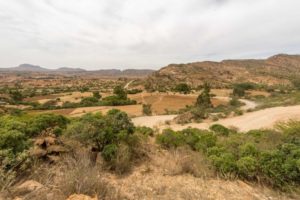
By Susan Onyango, originally published at ICRAF’s Agroforestry World Blog
Land degradation impacts the health and livelihoods of about 1.5 billion people worldwide. Further, the annual costs associated with land degradation worldwide is estimated to be US$ 231 billion as measured in terms of loss productivity and the costs to due to loss of ecosystems services.
Given that the state of the environment and food security are strongly interlinked in tropical landscapes, the increasing need for land for food production, urbanization and other uses pose several threats to sustainability in the long term. There is increasing recognition that more integrated approaches to ecosystem health assessments are needed to meet the targets of the 2030 Agenda, including SD 15.3 on combating desertification and restoring degraded land and soil. In addition to systematic and reliable biophysical and socio-economic assessments, stakeholder engagement with evidence is crucial.
The Global Symposium on Soil Organic Carbon, hosted by the Food and Agriculture Organization of the United Nations, FAO, in Rome, Italy from 21-23 March 2017, brought together more than 300 participants to act on worldwide ambitions to preserve soil organic carbon and re-carbonizing degraded soils. The objective of the symposium was to review the role of soil and soil organic carbon in the context of climate change and sustainable evidence, and to build scientific evidence that will contribute to the IPCC Assessment Reports and reports to UNFCCC, UNCCD and on the SDGs.
Leigh Ann Winowiecki, soil scientist, and Tor-Gunnar Vågen, senior scientist, at the World Agroforestry Centre (ICRAF) presented advanced analytics on soil carbon accounting and highlighted integrated approaches for stakeholder engagement with evidence using ICRAF’s SHARED approach, a demand driven, tailored and interactive engagement process. Their presentation, “Spatial assessments for the mapping and monitoring of soil organic carbon: Using stakeholder engagement processes”, co-authored by Constance Neely, Sabrina Chesterman and Mieke Bourne, demonstrated the integration of land and soil health maps with socio-economic datasets. Kenya’s Turkana County Government’s Resilience Diagnostic and Decision Support Tool was developed using a similar approach.
“We have established maps of soil organic carbon for the continent of Africa and are creating a large systematic database of soil organic carbon across the tropics. These maps can be used for prioritizing initiatives and baseline assessments for carbon accounting.” Leigh Ann Winowiecki, World Agroforestry Centre

Winowiecki and Vågen‘s presentation highlighted the advanced spatial mapping analytics available at the Centre’s GeoScience Lab. The analysis is supported by the project, Restoration of degraded land for food security and poverty reduction in East Africa and the Sahel: taking successes in land restoration to scale, funded by IFAD and the European Commission.
Symposium participants also engaged in discussions on maintaining and/or increasing soil organic carbon stocks for climate change mitigation and adaptation and the SDG 15.3 on land degradation neutrality, and on managing soil organic carbon in soils with high organic content.
A scientific document highlighting the role of soils and soil organic carbon management in meeting the climate change and sustainable development agendas will present an overview of state-of-the-art soil organic carbon monitoring, measures to maintain and enhance soil organic carbon, and recommended methods for monitoring and reporting soil organic carbon.
This research forms part of the CGIAR Research Program on Forests, Trees and Agroforestry.
Also see:
Presentation – Spatial assessments for the mapping and monitoring of soil organic carbon: Using stakeholder engagement processes
Vågen, T-G., Winowiecki, L.A., Neely, C., Chesterman, S., and Bourne, M. 2017. Spatial assessments for the mapping and monitoring of soil organic carbon- Using stakeholder engagement processes, a paper presented at the Global Symposium on Soil Carbon, Rome, Italy, 21-23 March 2017.
Vågen, Tor-G., Winowiecki, L., Tondoh, J.E., Desta, L.T. and Gumbricht, T. 2016. Mapping of soil properties and land degradation risk in Africa using MODIS reflectance. Geoderma. http://dx.doi.org/10.1016/j.geoderma.2015.06.023
Global Symposium on Soil Organic Carbon website
Project website: Restoration of degraded land for food security and property reduction in East Africa and the Sahel: taking success in land restoration to scale
World Agroforestry Centre Landscapes Portal
Blog: Put soils first, African Soil Seminar concludes
For more information, contact Leigh Winowiecki at the World Agroforestry Centre: l.a.winowiecki@cgiar.org
We thank the European Commission and IFAD for financing the project, Restoration of degraded land for food security and poverty reduction in East Africa and the Sahel: taking successes to scale.











